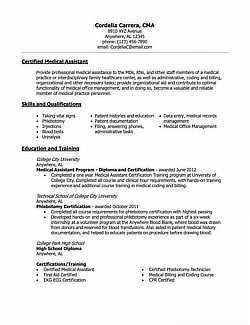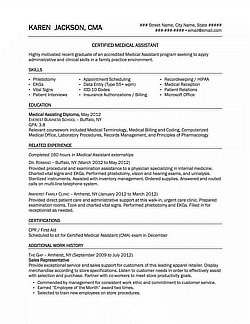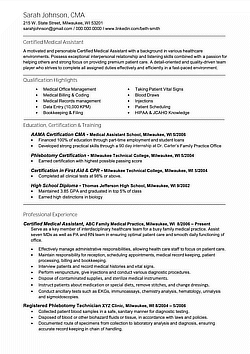Table of Contents
- Online or hard-copy resume?
- Step 1: Get to know your target employer
- Step 2: Identify your assets
- Step 3: Transferable and job-related skills
- Step 4: Presenting your accomplishments
- Step 5: Identify keywords and buzzwords
- Types of resume
- Step 6: Choose the format that is right for you
- Step 7: The structure and layout
- Medical assistant resume examples
Your resume is, most often, the only way for you to make a great first impression on a potential employer.
In the first few seconds (between 15 and 30) an employer will either be motivated to continue reading or they will set you (your resume) aside and move on to the next applicant.
The goal is to make you, your skills, and your education and experience as a medical assistant stand out from the rest, so make it the best it can be.
This guide will cover the two main parts of resume creation:
- Gathering and selecting pertinent information.
- Writing and arranging that information into a presentation that is pleasing to the eye. As well as a hard-hitting marketing tool that commands the attention of the doctor or medical facility’s human resources department.
Hopefully, it will help you brand yourself as a highly qualified MA that an employer is willing to invite to an interview for a more thorough screening.
Online (digital) or hard-copy (paper) resume?
Because you live in a world that is very diverse and you may be applying for medical assistant jobs across a variety of small and large offices/facilities, it’s a good idea to have both.
You’ll need to be able to send your resume as an email attachment or in the body of an email, depending on the employer’s requirements.
You’ll also need to be able to upload a resume to medical assistant resume databases and medical field job boards. Some of them allow a variety of documents such as MS Word and Adobe PDF files.
Others require that you copy & paste your resume into a text box that will put your information into a database. This will require a plain text resume using a font such as Arial.
On the other hand, if you are attending a job fair or applying for a position with a small doctor’s office, you may need to present them with a hard copy of your resume.
It’s always a good idea to have one on hand for those times that you may run into a doctor, PA, or office manager when you’re networking.
What you should have in your resume arsenal:
- Digital copy of your resume (online and email)
- Plain text copy of your resume (online and email)
- Hard copy of your resume (paper copy for job fairs, small offices, networking)
Whatever the need or occasion, it’s best to be prepared for all contingencies. Job search is a full-time job and you never know when an opportunity may arise.
The more tools you have at your disposal, the more likely you are to quickly land your ideal position.
Gathering your information — Step 1: Get to know your target employer
As with any other marketing campaign, your job search requires some research.
The first thing you should do is identify the type of environments you want to work in. Is it a hospital or large clinic setting? Do you want to work in sports medicine or family practice?
Don’t limit yourself to a single area, but choose a few environments that you’d be comfortable in. For example, you could select:
- sports medicine in private practice
- long-term care facilities
- rehabilitation
Once you have selected your key markets, you should identify a number of potential employers in that area of medicine.
Create a list of potential employers across key markets and do your homework, taking notes as you go.
- Study postings and help wanted ads to identify buzz words and specific skill sets that each ad has in common. Address these in your resume.
- Do some Internet research. Find as many of the specific practices and facilities as you can and visit their websites. Some will have job listings and online applications available.
- Identify what they most seek in an employee. Use it to your advantage in your resume.
- Contact the hiring manager or human resources department. Let them know you’re interested in a position and find out if there’s anything they’re looking for that isn’t listed in the job posting.
- Do they have a LinkedIn, Facebook or other social media account? Give their pages a quick review.
- Talk to other people who work for the practice, clinic, facility, or hospital to get a good feel about what their interview/hiring practices are like and what they expect from their medical assistants.
Step 2: Identify your assets
Don’t hold back. Write down everything your mind can think of and forget about being polite. Your mother probably taught you not to brag, but here is the place you do.
If you don’t boast of your accomplishments, no one will.
Make a list of your employment experience, both paid and unpaid. Unpaid experiences might include things like:
- serving as a teaching assistant for your Biology teacher
- or volunteering in a health care facility
Internships (paid and unpaid) should be listed along with the number of hours or weeks you completed and the type of responsibilities you had.
Educational information should include your degree level, major and minor studies, number of credits in the program, and your GPA.
Anyone with a GPA of 3.0 or higher should make this achievement part of their resume
Certifications: You should list everything – medical assistant certification, program credentials, CPR certification, and anything else you’ve accomplished.
Awards and Special Recognition are well received by potential employers. Did you make the honor roll, Dean’s list, graduate with honors, belong to a sorority or fraternity that recognized you for something? Put it on your list of assets.
Technical skills are a must in today’s workplace. Don’t be shy when you list your computer skills and proficiencies. These can include everything from:
- Internet research skills
- Email communications
- Microsoft Word or Excel
If you have learned to use medical related software, are savvy with computers and mobile devices, be sure to include these things.
Gather your references and ask them if you can use them for your job search.
It’s a good idea not to use former managers and employers (they will be listed on an application), but:
- Former teachers
- Colleagues
- Students
- Co-workers
who are familiar with your work ethic and medical assisting skills are great to put on a reference list.
Never include your references on your resume it takes up valuable space. Keep them on a list that you can give to a potential employer at an interview or when requested.
Step 3: Identify your transferable and job-related skill sets
Transferable skills are a very important part of your experience. As a MA this part of your experience can be the thing that helps a hiring manager, doctor, or medical office manager decide whether, or not, to call you in for an interview.
The following skills are highly respected in a good medical assistant:
- Interpersonal communication (speaking clearly and listening carefully)
- Displaying compassion and empathy
- Ability to make sound decisions in a fast-paced/high-stress environment
- Good customer service
- Record keeping and documentation
Job related skills that you should address included, but are not limited to, areas of education and experience in your selected area of expertise, such as orthopedics, podiatry, pediatrics, and administration.
Based on your selected occupational specialty, your job skills might include the following:
- Recording patients’ medical history, vital statistics, or information such as test results in medical records.
- Preparing treatment rooms for patient examinations,
- Interviewing patients to obtain medical information.
- Cleaning and sterilizing instruments and disposing of contaminated supplies.
- Preparing and administering medications as directed by a physician.
- Showing patients to examination rooms and preparing them for the physician.
- Explaining treatment procedures, medications, diets, or physicians’ instructions.
- Etc.
Physicians and hiring managers will be looking for all of the skill sets listed in their job posting.
If you don’t include these skills, along with the right keywords or buzz words you may be overlooked by the screening application or human resources person reviewing your resume.
Step 4: Presenting your accomplishments
Effective presentation of accomplishments gives potential employers a reason to set your resume in the “call for an interview” pile.
Use the CAR formula of presentation to create the desired effect on the reader:
- (C)hallenge: What challenge were you faced with?
- (A)ction: What action did you take to solve the problem?
- (R)esult: What was the result?
| Challenge | Action | Result |
|---|---|---|
| New practice with no organizational procedures for patient room assignments | Developed and suggested rotational system for patients based on expected length of visit | Highly effective system of room assignment that allowed for tending patient needs and increasing number of patients seen on a daily basis |
| Moving physical records to automated medical recordkeeping system | Prepared and scanned records for input into new system |
Finished job in 8 weeks |
Based on the above CAR method, you could create accomplishment bullets that read like this:
Joined a new practice with no previous system for room assignments and worked with the team to create a highly effective rotational system that ensured patient needs were met while increasing number of patients seen on a daily basis.
As an intern with the SD medical records department, prepared over 5,000 patient records for input into new, automated medical record keeping system in only 8 weeks.
Step 5: Identify keywords and buzzwords
Many employers (hospitals etc.), today, use resume databases and keyword search queries to select applicants. These systems look for keywords that are, most likely, listed in a job posting.
Once entered into the tracking system and database, resumes are held there for a specific period of time and searched over and over again.
If your resume doesn’t contain the specific language (keywords) the employer is looking for, your resume might get lost like a needle in a haystack.
Some keywords or phrases that are specific to a medical assistant resume include:
- Certified Medical Assistant (CMA)
- Front Office, Back Office
- Phlebotomy
- Patient Records
- Medial Billing
- Detail Oriented
- Maintain Confidentiality
- Interpersonal Communication
- Team Player
- Vital Statistics
- Prepare Patients
- Administer Medications
- Take Medical History
- Assist Physicians
This is not a complete list of the keywords that could be used.
You should read the job posting, identify specific keywords that may not be in your resume and tweak your resume before submission to a potential employer.
Writing your resume: Types of resume
There are three basic types of resume. You should choose the one that’s most pertinent to your circumstances and experiences.
Chronological format:
This format is suitable for those with more work experience and multiple positions. The jobs should be listed in reverse-chronological order starting with the most recent down to the oldest.
It should show a consistent or upwardly mobile work history of a period of several years.
Functional format:
Best suited for those with little to no work history or internships, or with a spotty work history.
This format focuses more on skills, accomplishments, and education without a dated work history, but may include employer’s names and job titles.
Hybrid format:
This combines the chronological and functional resume into a document that allows you to highlight skills, accomplishments at the beginning of the resume, and then expand on your education and work experience in more detail.
Step 6: Choose the resume format that is right for you
In most cases a new graduate will want to highlight their skills and accomplishments, and then give more details about education, internships, and previous positions.
In case you don’t have a lot of experience, you may want to start with the hybrid format.
Step 7: The structure and layout of your resume
Here are a few guidelines that you should follow in creating your resume:
- Don’t cramp the page or use very tiny fonts, use lots of white space. The person should be able to easily identify sections and not have to search too hard for keywords.
- NEVER lie on a resume or embellish your accomplishments. An employ will check.
- Don’t be afraid to boast, but be factual and polite about it.
Below is a simplified layout on how to organize your resume
Resume Layout
-
Header section
Include your full name, physical address, telephone number, and email address, social network page or profile.

-
Summary section
Could also be called a profile. Present yourself: give a brief overview of your personal abilities. An opening line might go something like…
“Personable, detail-oriented team-player with a strong desire to find meaningful employment in a private-practice setting.” -
Qualifications section
These skill sets could be displayed in a table or a bulleted list. This is where your keywords come in handy.
Select 8-10 of your best skills and lay them out in a manner that draws the attention of either the database query or the human reviewer.
It could be: Laboratory Procedures, Interpersonal Communication, Record Keeping etc.
-
Accomplishments section
This is where you would include the 3-4 most outstanding accomplishments of your career. This could be graduating with high honors, participating in an exclusive class project etc.
-
Education section
For a new graduate (and for up to five years afterward), education should be listed ahead of work experience. After five years the education should be moved below the work experience.
Include the name of the school, the program, and any honors or special accomplishments not already listed. If you don’t have any work experience in medical assistant field, it’s a good idea to use this space to list your coursework and extra-curricular activities. -
Certification section
List your certifications, date of certification, and certifying agency
-
Work experience section
Include work study, internships, and other jobs. If including previous, unrelated jobs, use the job description to identify medical assistant-related transferable skills.
-
Technology section
List everything you know about computers, Internet research, record keeping applications, databases, and all types of software and hardware you are familiar with.
Now you should be prepared for the actual writing of the resume. Here are a few rules of thumb.
- Be concise: Give the information in as few words as possible. Flowers and fluff are unnecessary.
- Make it for a potential employer easy to scan, assuring the buzz words are easy to see among the rest of the verbiage, but do NOT overuse bold, italic, or underlined words.
- Use bullet lists where appropriate, but be consistent in the content of those points. Use either phrases (no period) or sentences with period at the end. Don’t mix them in the same set of bullet points.
- Double check the tenses. If it was done in the past make it past tense. If it is currently part of your routine or responsibilities, use present tense.
- Black print on white paper or background is the easiest to read. Avoid the urge to add colors and decorations.
The final step is the proofreading. Don’t leave any mistakes for a reviewer to pick up on.
After you think it’s perfect, have at least two friends read it for errors as well. If you don’t have anyone to proofread it for you, use your social networks.
When you’ve had it read and re-read, let it sit for a day or two, then go back and read it again. Now it should be ready to submit to employers.
Medical assistant resume examples
Note that these examples are for reference only, so you are free to use them as inspiration.
Instead of writing a generic resume, or even worse, lying or making things up, you are always better off tailoring it to the specific needs of your potential employer.




